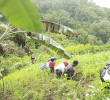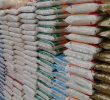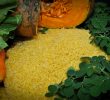DAVAO CITY, Philippines — “The struggle is real, and we are dying each day, in case they don’t know that.”
Tatay Duroy said over the phone, his voice barely containing anger and worry over the hardships he and fellow farmers in Tulunan, North Cotabato had to endure in the past years.
Duroy has been a farmer for forty years. In the past, his rice product is “somehow enough” to put food on the table for his and spend some for his children in school.
But now, farming can barely sustain their daily needs with the drought, pandemic and cheaper imported rice in the market affecting him and other farmers in the province.
Rice Tariffication
The Rice Tariffication Law (RTL) was signed in 2019 as an immediate solution of the Duterte government to the shortage of local rice supply. But that opened the floodgates of cheaper rice imports that hit the selling price of local rice farmers like Duroy.
“It is not in any way advantageous to struggling local farmers,” Tatay Duroy said. “Imported rice will kill us in the near future since it now dominated the local market.”
“Traders will prefer imported rice than local rice because it will cost them cheaper. Buying local rice will cost them double from drying to milling compared to importing rice where they can directly distribute it to their sellers,” Duroy explained.
During the 2016 drought that affected North Cotabato, the buying price of rice is around P14 per kilo while traders buy both yellow and white corn for P9 to P 11 for a kilo. The price rose to P18 at the beginning of the Duterte years.
With RTL, traders are buying local rice as low as nine to 13 pesos.
Rising costs, piling debts
The impact of cheap buying price has forced Tatay Duroy and farmers in his province of North Cotabato to harvest their products right away to recoup with capital and to pay debts.
“Our debt and interest are getting bigger because we cannot pay them. Other farmers are forced to sell their land or allow the landlord to convert the land into a plantation even if the rent is too small,” he said.
On average, a rice harvest can yield up to 120 sacks in one hectare, and as low as 50 sacks in a bad season affected by drought, floods or pests.
A sack of rice grain is equivalent to 50 to 65 kilos and will cost P864 excluding deductions.
The expenses include P8,000 for the rental of a tractor for preparing the rice land before planting. A cheaper option is to rent a carabao for P600 a day but it would take longer days for the preparation.
For rice cropping for one hectare, a farmer fills these with three sacks of rice seeds that costs a minimum of P7,500, and seven liters of herbicide or weedicide that costs P1,200 at the minimum.
Farmers need to fertilize the plants through the whole cropping season, which needs a minimum of nine sacks costing around P1,300 to P1,500.
Farmers also spend labor to speed up the work which costs around P4,000 to P6,000. They are also obliged to pay farm labor either with two sacks of the rice grain or P2,000 per cropping for irrigation.
Another expense for harvesting includes paying tractor harvesters either one sack of rice for every 25 sacks harvested. Harvesters who do it by hand will receive one sack per 11 sacks of harvested rice grains.
Such costs has forced farmers to do their work by themselves, such as Tatay Felix from M’lang, a neighboring town in North Cotabato.
“It is very expensive so we tried to minimize the expenses by doing double work but most of the time the only option is to borrow money to sustain the cropping,” said Felix.
Usury has been the practice of rice traders to lend money to farmers to sustain the farms until harvest with capital including farm inputs with interest as high up to 10 percent.
For that reason, farmers like Felix are indebted to traders, and are forced to sell their product at a lower price. Farmers’ harvest are also deducted one kilo for every sack owed to the trader, and another deduction if the sacks get muddy.
Traders in the province also designed classifications of rice grains to their advantage. Classifications such as semi-dry, semi-green, wet and spotted means a deduction of P10 per sack.
“When we arrive, they will check the grains and put those classifications. Even if our grain is in good quality, we still expect deductions, because that is how it works here and cannot argue against that,” Tatay Felix said.
The National Food Authority (NFA) also buys grains from farmers at a higher price but its guidelines are strict, such as requiring grains to meet 14% moisture with 95% dryness and purity.
Pandemic woes
The low buying price brought by rice liberalization has been killing farmers and the local economy.
M’lang Vice Mayor Lito Piñol said that if RTL favors the consumers, it does not favor the survival of small food producers.
Piñol said that the rice variety of local farmers cannot compete with the long grain variety of imported rice which is now leading in the market.
“How can our farmers compete with imported rice when we are still using a backward way of farming? Where is the rice tariffication assistance that the government promised to give our farmers? For more than a year, not even one harvester, one tractor, or one Caltex of fertilizer was given to our farmers,” Piňol asked.
Piňol said the Covid-19 pandemic contributed to the slowdown of agriculture activity. Health protocols and border to border restrictions made the situation more difficult for farmers to continue the production. These restrictions affect the entry of mechanical tractors and harvesters as well as manual labor for planting and harvest.
“Our planters and harvesters, even machine operators cannot enter without following different community protocols. So when harvest season started we don’t have enough manpower anymore,” he said.
Farmers in North Cotabato have experienced successive setbacks in the past years.
A drought that began in late 2015 until the first half of 2016 dried up the farms. This forced 5,000 farmers, including Duroy and Felix, to barricade the highway fronting NFA in the province’s capital city of Kidapawan demanding food assistance from the local government. They were instead met with bullets that killed two farmers and wounded 15 others. Scores were arrested but freed by the courts.
But Tatay Felix said that if this crisis continues under this pandemic, it will surely result to another huge protest to urge the government to do appropriate action for the struggling farmers. (davaotoday.com)
Business, consumer, duterte, Economy, farmers, Food, hunger, Mindanao, Mindanao economy, pandemic, Peasant, philippine economy, politics, poverty, rice liberalization, rice tariffication law, RTL









